Relationship marketing is important in every business. Clients keep your business running. Getting them is one thing, but keeping them is a whole different story.
Customer loyalty can ensure a strong long-term relationship with your clients. Having the right tools to manage them and deliver what they need can lead you into that direction. We think that business success relies on the number of satisfied customers, plus other ingredients that make the strategy “spicier” – more elaborated and powerful.

Check out these effective relationship marketing strategies to maintain, engage and convert your clients.
- Market Your Customers the Right Way
- Build a Great Customer Service Team
- Create Customer Service Q&A Templates
- Implement the A.C.A.F. Customer Feedback Loop
- Build an Automated Customer Support Process
- Always Improve Customer Experience
- Setup Specific Customer Retention Actions
- Reward Loyal Customers
- Set up a Referral Program
- Follow Sales Number and Customer Feedback Metrics
- Invest in CRM and Other Technology
- Create Valuable Content Based on Customers’ Questions
1. Market Your Customers the Right Way

Before you start building a relationship marketing strategy, you need to know your audience to connect with it. If you’re struggling to figure out your niche, you can follow the following instructions:
- Identify your interests, what you’re good at and what you sell. It is important to know your skills very well, as well as your products or services.
- Identify what problem you can solve, whether there’s a market for your niche and if your services can help the user.
- Research your competition and see what they’re doing, what they are promoting and what their asset is.
- Test your niche.
Your clients are an important asset to your business; they make your business work. Your business will exist as long as you have clients. More benefits come from your loyal customers because they continue to bring monetary value to the company. You need to maintain your customers engaged to keep them loyal.
According to Gallup’s customer database, half of all customers are satisfied and only 38% of them say they are engaged.
Customer engagement doesn’t automatically follow satisfaction.
Loyal customers need attention to keep their engagement rate high. According to Experience Matters, loyal customers are 5x as likely to repurchase, 5x as likely to forgive, 4x as likely to refer, and 7x as likely to try a new offering. Loyal customers are more likely to create customer lifetime value (CLV).

Source: Kissmetrics
2. Build a Great Customer Service Team

It all starts with building a team to execute quality experience. Helping your customers understand the value of your services is highly important. You need to help them learn your services by making it easier. It’s just like in UX design, the users have a path and your website should follow that path. The picture below is a good representation:
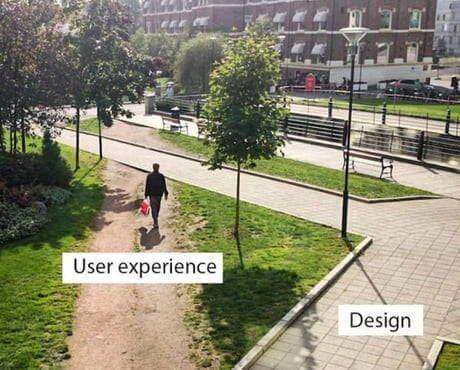
As we all probably already know, UX is very important for SEO, too. Many experts think that UX is crucial in the future of SEO, especially with all the evolution of machine learning technology. And UX goes beyond SEO, your team must see what the user wants, what they need, how your services benefit them and achieve their goal.
Helping customers understand and value your product over your competitors’ is not a sales tactic.
Your support team is in the first line, talking and keeping contact with your customers. Building a great customer service team is number one in developing relationship marketing. Promote a customer-centric policy to your team and try to engage them in providing high customer support services. Your team should know how to deal with both negative and positive situations and offer satisfaction to the user.
3. Create Customer Service Q&A Templates

To know how to deal in both negative and positive situations you’ll need a Q&A template, that can be modified depending on the user’s needs. There are lots of companies specialized in all sorts of activities, but every single one of them receives lots of questions about what they do, and how they can help the user. A template offers great support.
There might be cases when the conversations can be nuanced and get a little tricky. That’s why it is good to have a plan: you can get some ideas, keep you out of trouble and please the customer at the same time.
HelpScout created helpful customer service questions and answer template picturing all sorts of situations.
For small businesses, it is easier to talk with customers and you don’t require an elaborated Q&A template. In case you have a SaaS or a business that is more complex, it would be awesome if you had some documentation. It could benefit both your team and your customers for future reference.
There are lots of situations when you don’t need to play by the book, and let the master team do the job. Skyscanner did an amazing job responding to a man who got stuck with a 47-year flight connection:
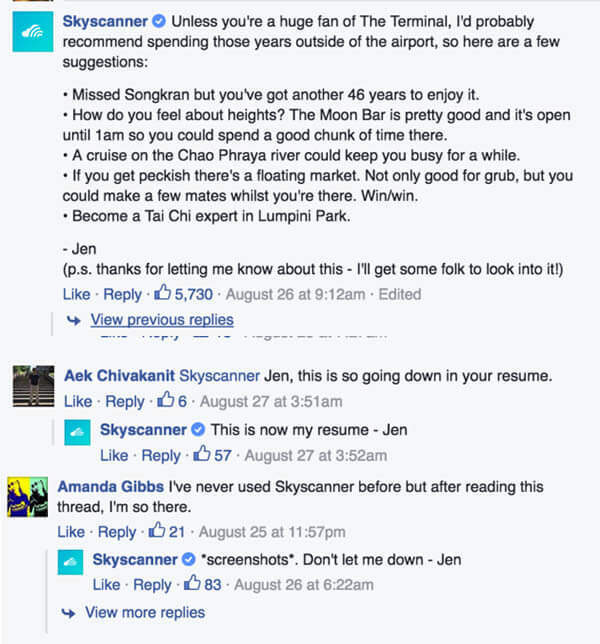
4. Implement the A.C.A.F. Customer Feedback Loop

Short for Ask, Categorize, Act, and Follow-up, the ACAF Customer Feedback Loop is a business strategy that centers itself on the customer. It has 4 steps:
- Ask for customer feedback to see what they need and if their needs are satisfied by your product.
- Categorize the feedback. It can be positive or negative, but usually there are 3 main categories: feedback regarding the product, customer service and marketing & sales. You need to see the reasons behind the words.
- Act on the feedback: share the feedback with the people in charge.
- Follow-up with customers who shared feedback.

Source: Hubspot
Feedback is very important in every business. It helps you evolve and correct the mistakes. Ask for valuable and personal customer feedback from your customers to see what you’re doing right and what’s wrong.
Always thank the customer for the feedback and make them feel appreciated. Not to mention feedback creates innovative opportunities, by hearing what your users need and you could develop in your product.
5. Build a Customer Support Process

Having a plan to provide quality customer support doesn’t require advanced technologies. You need to set up a process: the user sends a message, you need to assign conversations to other people, think about how to engage with the users, how to do the follow-up. After that, think about what to do with the email addresses to send them newsletters or send them special offers.
The customer support process tends to be more complex. You’ll need the following:
- the right team, that knows their responsibilities;
- a solid plan for dealing with issues;
- relevant metrics that need tracking and performance analysis;
- the right tools for dealing with customer queries and issues.
If you’re a small or mid-sized business, then you could use some free options. But an enterprise needs more advanced technologies. Having an automated customer support process can ease your work a lot. Practically, it can be a service such a help center or chatbot or any artificial intelligence, which will elaborate more at point 12. Also, you might need a more general business process management system if you would like to automate and ease more workflows in your company
6. Always Improve Customer Experience

Think of this: happy clients that had a good experience will return, unhappy clients that had unsatisfactory experience won’t return and can spread the bad word about the company. Studies show that almost 13% of unhappy clients tell to over 20 people about their bad experience.
Knowing what to say to your customers can be a daunting task. You can always improve your customer experience by providing excellent customer service using the right tools, quickly offering answers, solutions and trying to maintain a strong relationship with your customers.
It doesn’t really matter if your product or services are impeccable if user experience is shitty. It is highly important to resolve issues when they appear and provide a clean experience on site without any problems and errors.
More than that, you should actively engage customers on social media or blogs. It will strengthen the customer relationship and they can promote your business afterward.
7. Set up Specific Customer Retention Actions

Customer retention shows the companies’ ability to keep their customers for a period of time. A high retention rate means people (users, customers) that continue to bring revenue to the company and buy products.
Studies show that acquiring a new customer, however, is anywhere from 5 to 25 times more expensive than retaining existing ones. Retaining customers is a pretty important thing. Every single person thinks about the benefits they have when choosing a brand, a product or certain services. And the brand must think about how to keep those customers.
There are lots of customer retention strategies you can personalize for your clients to keep and bring ROI, but some of the most profitable are:
- personalized messages;
- social media interaction;
- persuade them through newsletters;
- keep the highest standard for customer support services;
- appreciate your clients;
- collect feedback through well-designed questionaires;
- build loyalty programs.
These actions can be developed into campaigns and create something really interesting depending on your niche and business. These may come in addition to the strategies we’ve elaborated in the whole article to lead you into setting up a more specific customer retention plan.
8. Reward Loyal Customers

Since we’ve mentioned brand loyalty, you must know it is a good strategy for relationship marketing. Customer loyalty works very well and can strengthen the relationship you have with your clients. Basically, a loyalty program shows you care about your customers first. Loyal customers are hard to acquire, but once you got them, it costs the business about 5-25x less to sell to an existing client than to acquire a new customer.
Every business should aspire to customer loyalty. It is a virtue of their existence. There are lots of ideas you could generate by building a loyalty program. You can send the message by email, using an App (if your business has something like that), to the user’s account and so on. It can be a discount, a gift, or something else depending on your creativity. You can also find lots of ways to reward loyal customers in the digital marketing space.
Uber, for example, rewarded Gold members with some interesting perks, not available for all members. The membership levels are Blue (0 points to qualify), Gold (500 points to qualify), Platinum (2500 points to qualify), and Diamond (7500 points to qualify). So, all the member that hit 500 points and join Uber Gold get flexible cancellations that refund your $5 cancellation fee if you rebook within 15 minutes. In addition, members get priority support.
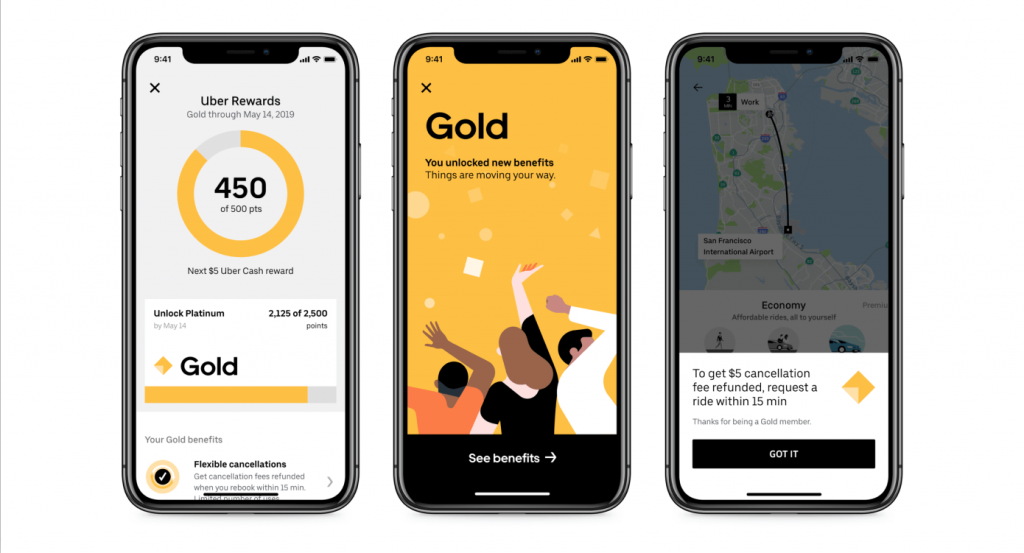
The Platinum and Diamond get a lot more services that make the ride more pleasant, such as:
- price protection on a route between two of your favorite places regardless of traffic or surge;
- priority pickups at airports;
- premium support with a dedicated phone line and fast 24/7 responses;
- complimentary upgrade surprises in high-end cars;
- no delivery fee for orders and many more.
Loyalty programs can boost your ROI and keep the customers that really matter.
9. Set up a Referral Program

Creating a referral program is born from customer satisfaction. People that are pleased with the services might tell other people about their experience, so why not take advantage of that? Encourage them and don’t leave room for second thoughts. Satisfied customers are willing to make referrals. Those who receive such referrals are more likely to pay attention to them rather than to the brand.
If you got the referrals engaged, then you’ll get some of the best new customers you can get.
If you want, we can set aside our reasons why you should use a referral program, and listen to the studies. R&G Technologies discovered that referral leads convert 30% better than leads generated from other marketing channels. More than that, referred customers have a 16% higher lifetime value.
There are lots of businesses that use the referral program. Booking, for example, gives you $15 if you recommend it to a friend. You have to invite your friends by sending them the referral link. They book and stay at the accommodation, then after their stay, you and your friend both get the $15 for the next booking.
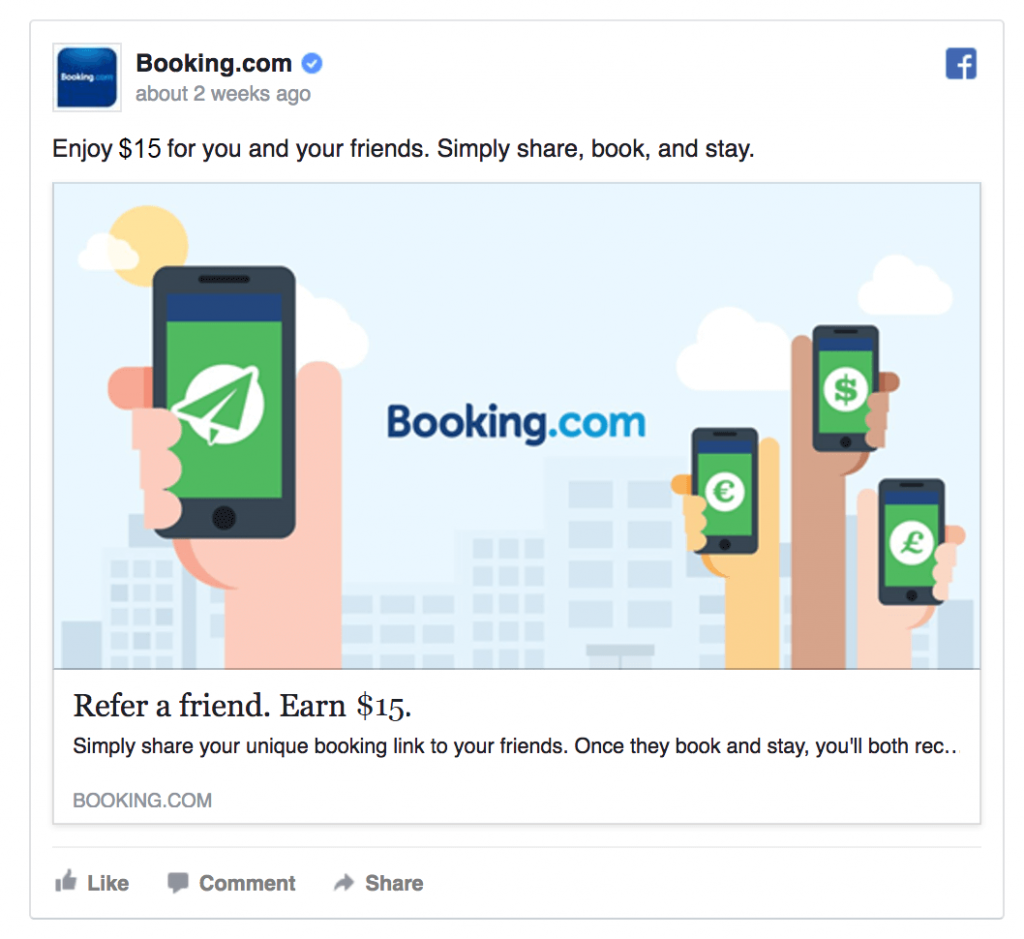
Your customers can become true advocates, by connecting and sharing your product with others when they have a good experience. Rewarding a satisfied customer through a referral marketing program doesn’t require so much work, and it can bring lots of benefits for everybody involved.
10. Follow Sales Number and Customer Feedback Metrics

Even if you focus on relationships, you shouldn’t miss customer data and numbers. In order to keep track of your business’s success, you’ll have to follow sales numbers and customer feedback metrics.
Some of the most important metrics in this situation is customer lifetime value (CLV). The formula for the metric is:
Estimated Average Lifetime Value = (Average Sale) x (Estimated Number of times customers purchased)
There are free tools that calculate the metric. Google Analytics, for example, measures lifetime value for users acquired through different channels. You need to select two Google Analytics metrics and compare them to identify the date range during which you acquired users. These are the metrics available:
- goal completions per user
- pageviews per user
- revenue per user
- session duration per user
- sessions per user
- transactions per user
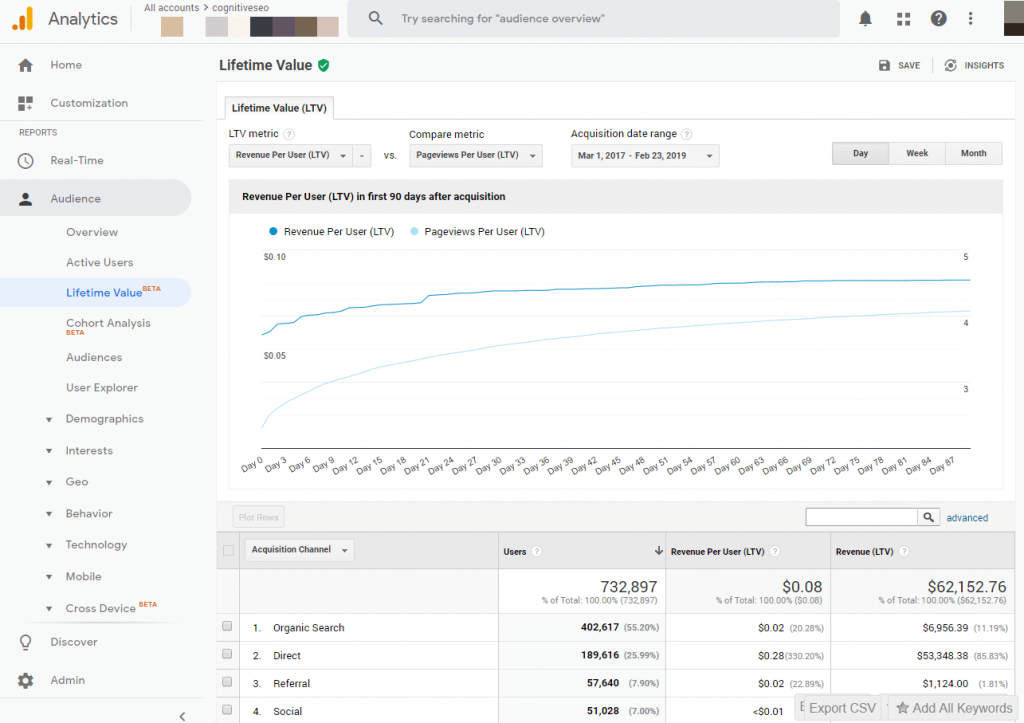
You can compare LTV in relation to the cost of customer acquisition (CAC) to measure how long it takes to regain the investment to get a new customer.
|
Marketers agree that growing CLV is essential to the health of their organization and a key success metric. |
|
| CRITEO | |
Conversion rate is another important metric that should be tracked. Conversions could be under lots of forms, depending on what business goals you’ve set. It can be:
- a newsletter subscription;
- signing up for an event;
- downloading white paper or guideline or something available on the website;
- sign-up for a live meeting/webinar;
- purchasing a product;
- creating an account on the website;
- calling the company and so on.
The are lots of other metrics you could follow, that can be tracked automatically with lots of services available that regards to the:
- experience with the brand;
- experience with the customer support team;
- experience with the product/services.
11. Invest in CRM and Other Technology
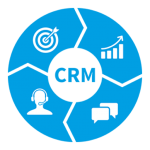
Businesses are more likely to become successful if they build a long-term relationship with their customers. Having a customer relationship management (CRM) strategy in place will bring lots of benefits in the future. You can say goodbye to tangled messages, no customer history in one place, hard customer management, no customer support flow, bad organization and many more. And you can create long-term customers more easily.
There are lots of customer relationship management tools that come in handy when you want to have an efficient and easy management with your customers. You can see customer’s history, lots of data and conversion numbers. Below you can see an example from such a CRM tool.

These tools can save you a lot of time to organize and customize your process. You are able to track and organize every stage of your sales pipeline, manage a large number of contacts, customize the steps as you wish.
For managing contacts and conversations you can use apps and services that include customer support technology. Intercom is an example. The messaging platform makes it very easy to:
- converse with clients;
- see lots of information about the contacts;
- look at the latest conversations;
- create auto messages;
- setup labels and filtering options for conversations;
- get reports;
- use chatbots and many more.

The tool is great for engaging and retaining customers.
12. Create Valuable Content Based on Customers’ Questions

Customer feedback, questions and conversations can be a great starting point for a new documented article. Generating article ideas based on your customers’ question will lead to a high open rate because you’ll talk about something that lots of people search. Imagine if all your articles answered your readers’ questions: the CTR would be very high.
There might times when marketers don’t write for the customers but rather for the industry, and they might lose a big part of the audience. If you write for your actual clients you could manage to acquire new customers.
Customers’ questions create content marketing gold.
When your current customers ask you questions it’s like finding our their needs very easily. You can see if there’s been a confusion, feedback, improvement, something they want to learn or any other thing. More than that, you can use that piece of content in the future as a reference in case there are other customers that ask you similar questions.
Conclusion
Maintaining a strong customer relationship isn’t the job of a single department. Everybody should work in order to fulfill customers’ needs. Sales teams are not entirely responsible. It should be a synergy.
Relationship marketing is a strategy that will foster customer loyalty and ensure long term engagement. You need to master this in order to bring customer retention and satisfaction.

 Site Explorer
Site Explorer Keyword tool
Keyword tool Google Algorithm Changes
Google Algorithm Changes

Leave a Reply!